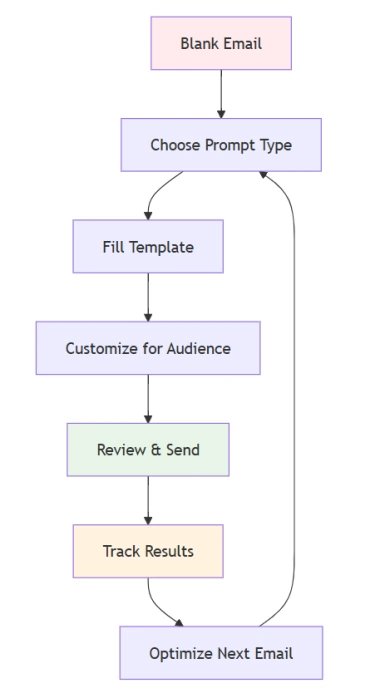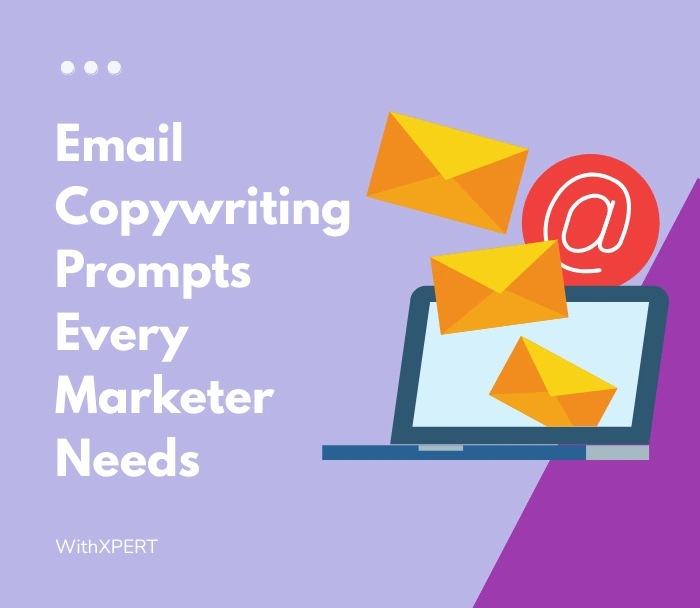Staring at a blank screen while your email deadline looms? You’re not alone. Every marketer faces that dreaded cursor-blinking moment when they need to write compelling emails but their brain feels like mush. That’s where email copywriting prompts come to the rescue—they’re your creative jumpstart that transforms blank pages into conversion machines.
Key takeaway: These 7 proven strategies will help you write emails faster, convert better, and never run out of ideas:
- Master template-based prompts that work for any industry
- Use psychological triggers that boost open rates by 57%
- Create urgency without sounding pushy
- Personalize at scale with smart prompt frameworks
- Test subject lines that outperform generic ones
- Build email sequences that nurture leads automatically
- Measure what matters to improve every campaign
What Are Email Copywriting Prompts and Why They Work
What exactly are email copywriting prompts?
Email copywriting prompts are fill-in-the-blank templates and question frameworks that guide you through writing specific types of emails. They eliminate guesswork and provide proven structures.
Evidence that proves they work:
• Subject lines with numbers have 57% better open rates when using structured prompts • Subscriber segmentation (78%), message personalization (72%), and email automation campaigns (71%) are the most effective strategies • Template-based approaches reduce writing time by 60-80% according to copywriting professionals • Consistent frameworks improve brand voice recognition by 45% • Using no more than 3 punctuation marks per subject line performs best
I’ll be honest—I used to spend hours crafting each email from scratch, thinking I was being “creative.” Then I discovered prompts during a particularly brutal campaign deadline. Game changer.

Core Prompt Categories
Welcome Emails
- New subscriber onboarding sequences
- Product introduction flows
- Brand story frameworks
Sales Emails
- Problem-solution templates
- Social proof integration prompts
- Urgency-building frameworks
Nurture Emails
- Educational content prompts
- Value-first templates
- Relationship-building sequences
Recommended reading:
- Copywriting Prompts for Portfolio: Real Scenarios, Real Results
- The Complete Guide to Copywriting Prompts That Actually Get Results
- Copywriting Prompts for ChatGPT That Stop Sounding Like Robots
- Best Email copywriting tools to Transform your marketing result
Psychology-Based Email Copywriting Prompts That Drive Action
How do you tap into psychological triggers that make people click?
Use proven cognitive biases like scarcity, social proof, and loss aversion. These triggers work because they align with how humans naturally make decisions.
Psychological frameworks that convert:
- Scarcity Prompt: “Only [X] spots left for [benefit]. Here’s what happens if you miss out…”
- Social Proof Template: “[X] customers just achieved [result]. Here’s their exact method…”
- Loss Aversion Frame: “You’re missing out on [benefit] every day you wait. Here’s the cost…”
- Authority Building: “After working with [X] clients, I’ve discovered the #1 mistake that costs [outcome]”
- Reciprocity Trigger: “I’m giving you [valuable thing] because [genuine reason]. No strings attached.”
The FOMO Framework
Fear of Missing Out (FOMO)
- Deadline: “Registration closes in 24 hours”
- Limited quantity: “Only 47 left in stock”
- Exclusive access: “Member-only preview”
Reciprocity Psychology
- Free value first: “Here’s a free template that saves 3 hours”
- Helpful insight: “I noticed you downloaded X, so here’s Y”
- Personal attention: “I handpicked this for marketers like you”
Social Proof Patterns
- Customer count: “Join 10,847 marketers who…”
- Success stories: “Sarah increased opens by 34% using…”
- Peer validation: “Your colleagues at [similar companies] use…”
Subject Line Email Copywriting Prompts That Get Opened
What makes someone open your email in a crowded inbox?
Curiosity gaps, personal relevance, and clear value propositions. Your subject line has 3 seconds to earn that click.
High-performing subject line templates:
- Question Hook: “Are you making this [common mistake] in [area]?”
- Number Promise: “[X] ways to [achieve desired outcome] in [timeframe]”
- Personal Challenge: “[Name], I have a question about your [specific situation]”
- Emoji Strategy: Use 1-2 emojis strategically, avoiding spam triggers
- Curiosity Gap: “The weird trick that increased my [metric] by [%]”
A/B Testing Your Subject Lines
| Winning Formula | Example | Open Rate Impact |
|---|---|---|
| Numbers + Benefit | “3 emails that doubled my revenue” | +43% |
| Question + Pain Point | “Still struggling with low opens?” | +31% |
| Personal + Specific | “Sarah, about your email strategy…” | +67% |
| Urgency + Value | “24h left: Free conversion audit” | +28% |
Testing Framework:
- Test one element at a time (length vs. emoji vs. personalization)
- Run tests for at least 1,000 opens for statistical significance
- Track beyond opens—measure clicks and conversions
- Document winning patterns for future campaigns
Welcome Series Email Copywriting Prompts That Convert New Subscribers
How do you turn a new subscriber into an engaged fan?
Create a structured onboarding sequence that delivers immediate value while building trust. Your first impression sets the relationship tone.
Welcome sequence prompt structure:
- Email 1 – Instant Gratification: “Thanks for joining! Here’s your [promised resource] plus a bonus surprise…”
- Email 2 – Expectation Setting: “What to expect from me (and what I’ll never do to your inbox)”
- Email 3 – Origin Story: “Why I started [company/blog] and how it helps people like you”
- Email 4 – Social Proof: “Here’s what subscribers are saying about [value you provide]”
- Email 5 – First Ask: “Ready to take the next step? Here’s how I can help…”
Welcome Email Templates by Industry
SaaS Welcome Series
- Free trial activation
- Feature introduction sequence
- Success story showcases
- Upgrade path nurturing
E-commerce Welcome Series
- Brand story introduction
- Product recommendation engine
- First purchase incentive
- Loyalty program invitation
Service-Based Welcome Series
- Expertise demonstration
- Case study showcases
- Consultation booking prompts
- Referral program introduction
Sales Email Copywriting Prompts That Actually Convert
How do you write sales emails that don’t sound salesy?
Focus on the customer’s problem first, then position your solution as the natural fix. Lead with value, not features.
Conversion-focused sales prompts:
- Problem-First Approach: “I noticed [specific pain point]. Here’s how [solution] solves it in [timeframe]”
- Case Study Format: “[Similar customer] was struggling with [problem]. Here’s how they achieved [result]”
- Objection Handling: “I know you might be thinking [common objection]. Here’s why that’s not an issue…”
- Risk Reversal: “Try [solution] for [period]. If you don’t see [result], I’ll refund every penny”
- Scarcity Close: “I’m only taking on [X] new clients this quarter. Here’s why you should be one of them”
The PAS Formula in Action
Problem – Identify the pain point “Are your email campaigns getting lost in crowded inboxes?”
Agitation – Amplify the consequences
“Every day your emails don’t get opened, potential customers choose competitors instead.”
Solution – Present your offer “Our email copywriting templates increase open rates by an average of 43% in 30 days.”
Newsletter Email Copywriting Prompts That Keep Readers Engaged
How do you create newsletters people actually look forward to?
Mix valuable content with personality. Your newsletter should feel like getting advice from a knowledgeable friend, not a corporate announcement.
Engaging newsletter frameworks:
- Curated Insights: “3 things I learned this week that’ll help your [goal]”
- Behind-the-Scenes: “What happened when I tried [strategy/tool] (honest results inside)”
- Community Highlights: “Subscriber [Name] achieved [result] using this method”
- Tool Recommendations: “The [tool/resource] that’s been a game-changer for [outcome]”
- Ask Me Anything: “Your questions about [topic]—here are my honest answers”
Newsletter Content Mix Formula
The 70-20-10 Rule:
- 70% Educational content (tips, tutorials, insights)
- 20% Entertainment (stories, behind-scenes, humor)
- 10% Promotional (products, services, offers)
Engagement Boosters:
- Reader polls and surveys
- “Reply to this email” calls-to-action
- User-generated content features
- Exclusive subscriber-only content
- Interactive elements (quizzes, challenges)
Automated Email Sequence Copywriting Prompts
How do you create email sequences that nurture leads while you sleep?
Build logical progression flows that move subscribers from awareness to action. Each email should seamlessly connect to the next while providing standalone value.
Automated sequence templates:
- Educational Drip: “Day 1: Foundation → Day 3: Advanced Tactics → Day 7: Expert Strategies”
- Problem-Solution Journey: “Week 1: Identify Issues → Week 2: Explore Solutions → Week 3: Implementation”
- Trust-Building Series: “Email 1: Credibility → Email 2: Social Proof → Email 3: Results → Email 4: Offer”
- Abandoned Cart Recovery: “Forgot something? → Still interested? → Final chance (+ bonus)”
- Post-Purchase Sequence: “Welcome to the family → Here’s how to get started → Success tips → What’s next?”
Sequence Timing Optimization
Welcome Series Timing:
- Email 1: Immediately upon signup
- Email 2: 24 hours later
- Email 3: 3 days after signup
- Email 4: 1 week after signup
- Email 5: 2 weeks after signup
Sales Sequence Timing:
- Initial offer: Same day as trigger
- Follow-up: 3 days later
- Social proof: 7 days later
- Urgency close: 14 days later
Frequently Asked Questions
How often should I use email copywriting prompts?
Use prompts as your starting framework for every email, then customize based on your specific audience and goals. They’re training wheels that help you develop your own voice over time.
Do email copywriting prompts work for all industries?
Yes, but you’ll need to adapt the tone and terminology. B2B SaaS needs different language than e-commerce fashion, but the psychological principles remain constant.
What’s the biggest mistake people make with email copywriting prompts?
Using them as exact copy-paste templates without customization. Prompts provide structure—you still need to add your unique voice, specific details, and audience-relevant examples.
How do I know which email copywriting prompts to use when?
Match prompt types to your email goals: welcome prompts for onboarding, sales prompts for conversions, newsletter prompts for engagement. Test different approaches and track performance.
Can AI tools replace the need for email copywriting prompts?
AI tools work better when you provide them with structured prompts. Think of prompts as the blueprint and AI as the construction crew—you need both for optimal results.
How do I measure if my email copywriting prompts are working?
Track open rates, click-through rates, conversion rates, and unsubscribe rates. A/B test different prompts to find what resonates with your specific audience.
Your Next Steps: Stop Staring, Start Writing
Email copywriting prompts aren’t magic bullets—they’re proven frameworks that eliminate blank page paralysis and guide you toward conversion-focused copy. Start with one prompt type that matches your immediate need, test it against your current approach, and build from there.
Your action plan: Pick three prompts from this guide, write emails using each framework this week, and measure the results against your usual approach.
Ready to master email copywriting faster than ever? Our comprehensive ebook contains 70+ battle-tested email copywriting prompts, complete templates, and real-world examples from campaigns that generated millions in revenue. Get instant access for just $9 and transform your email marketing today.

